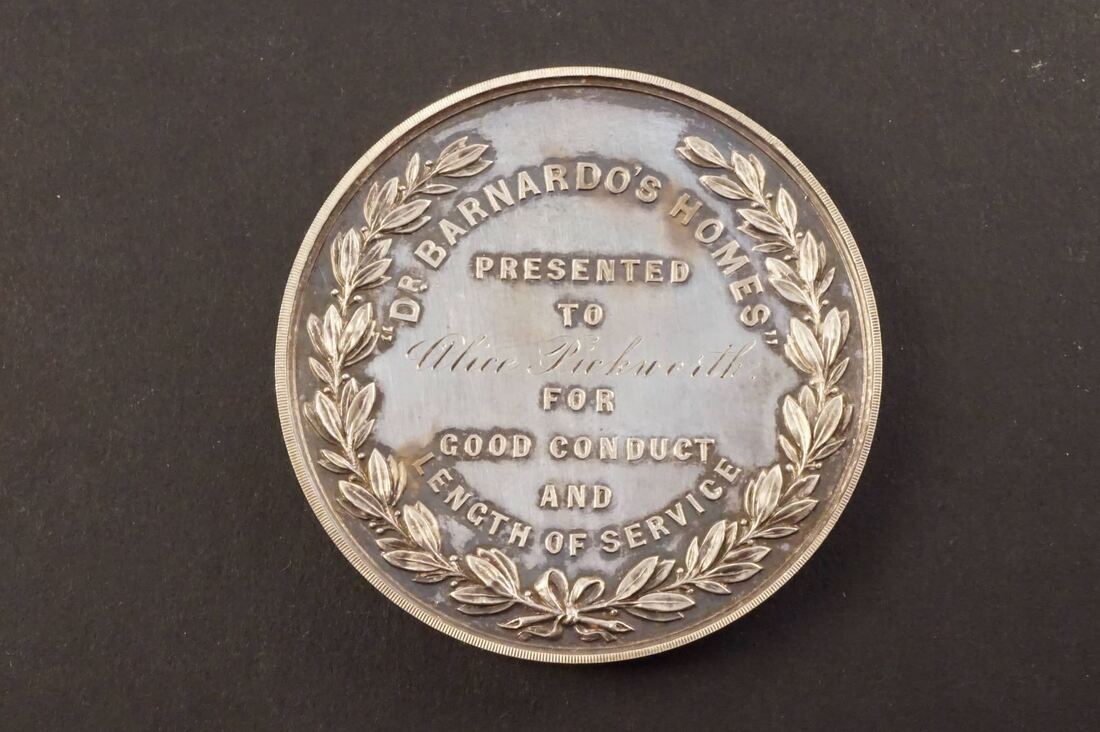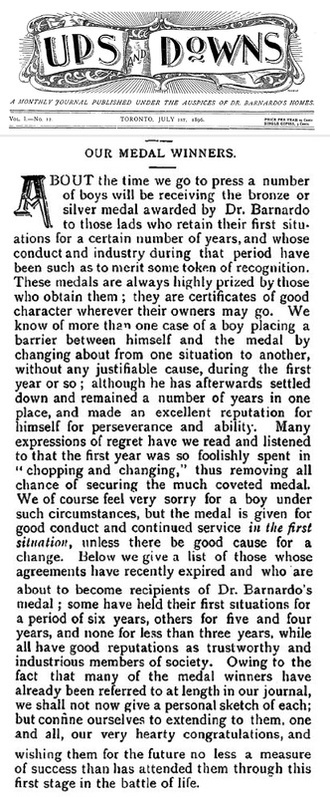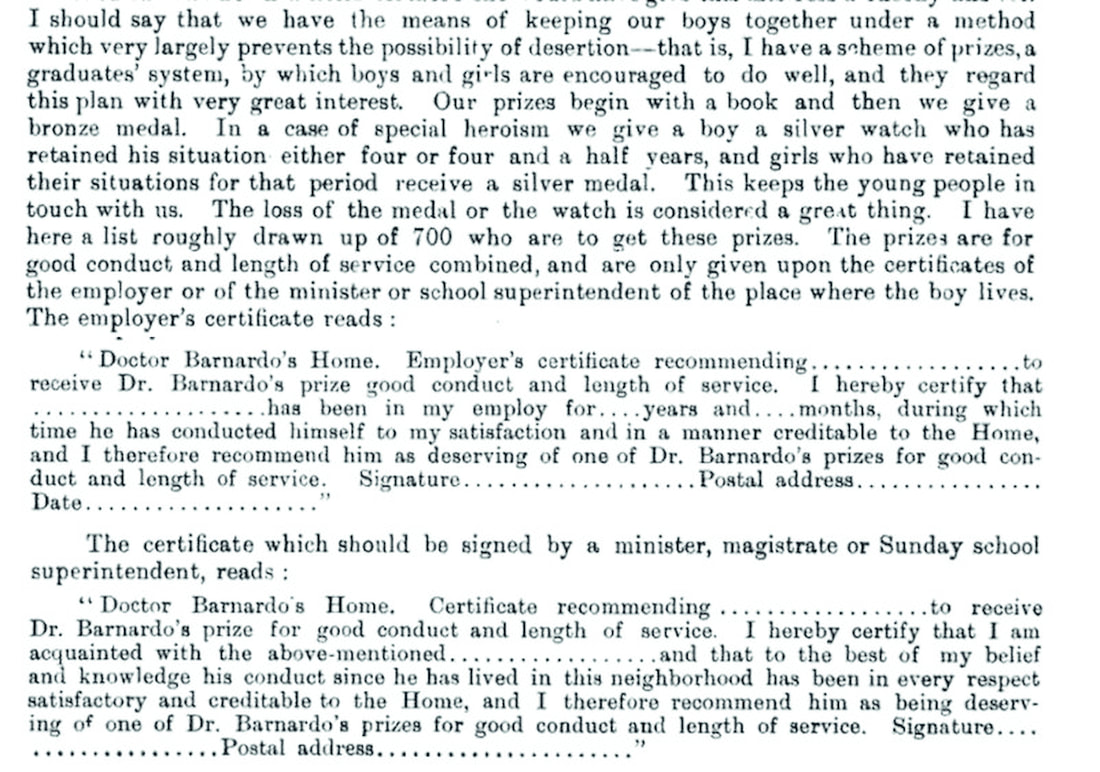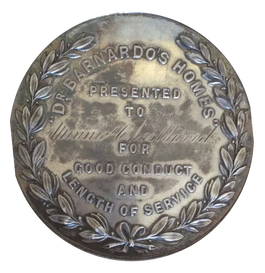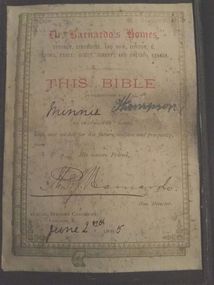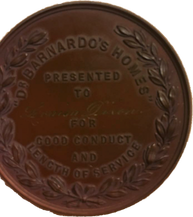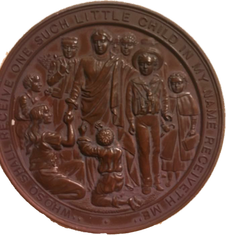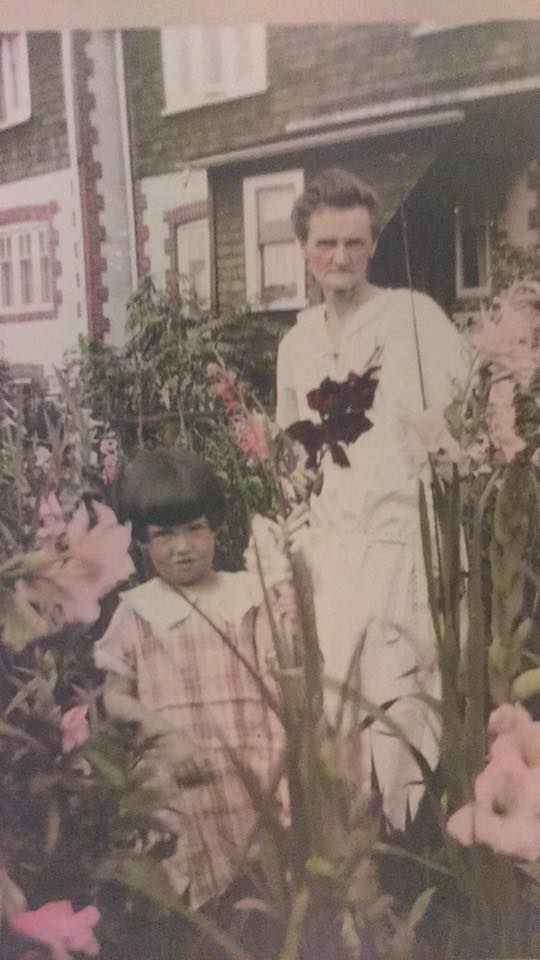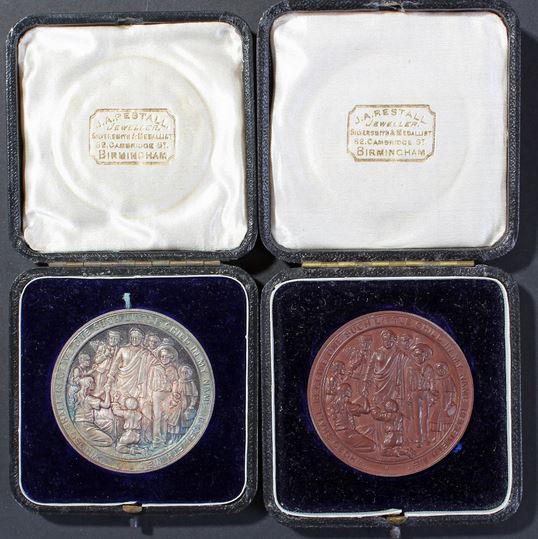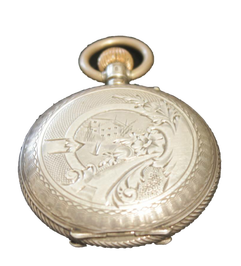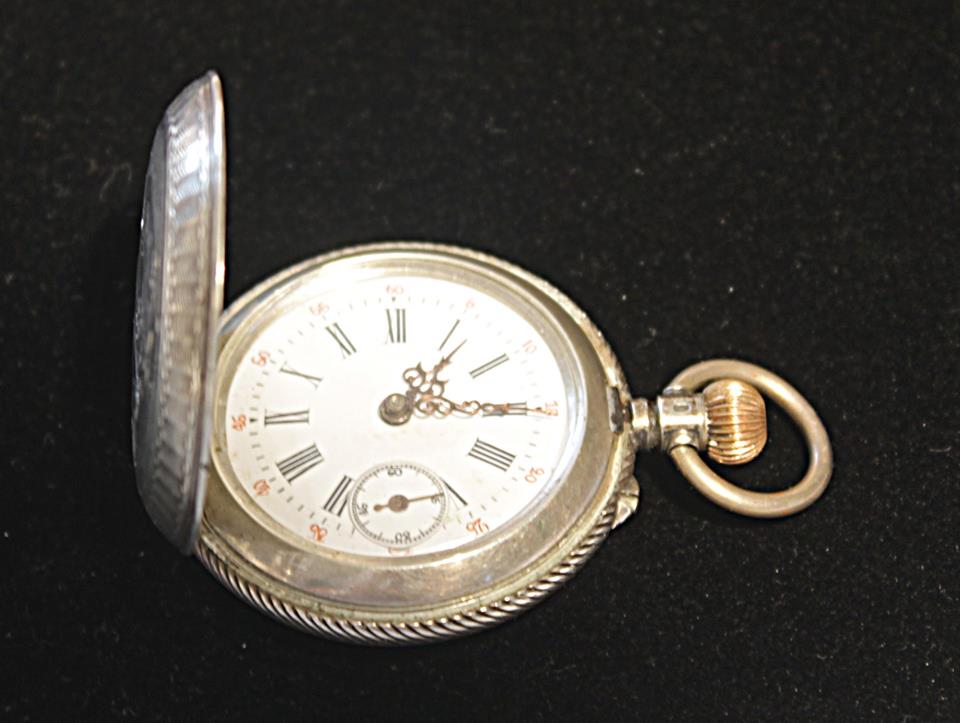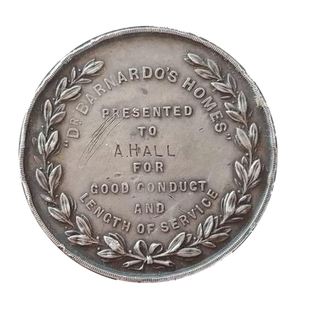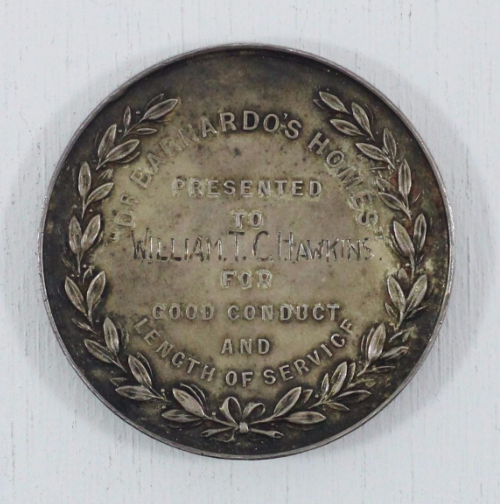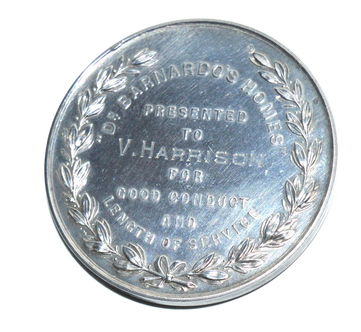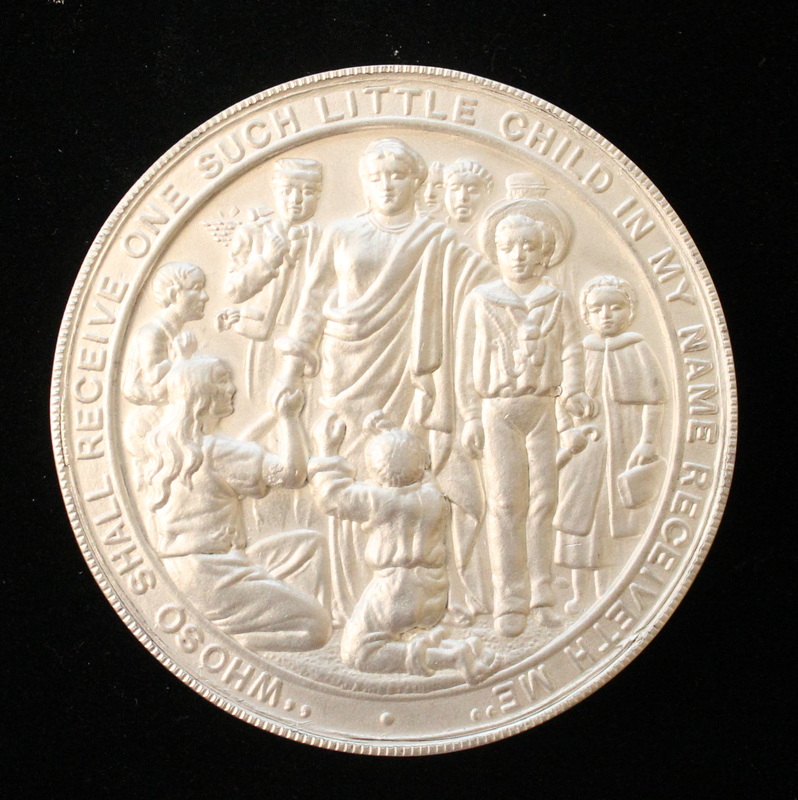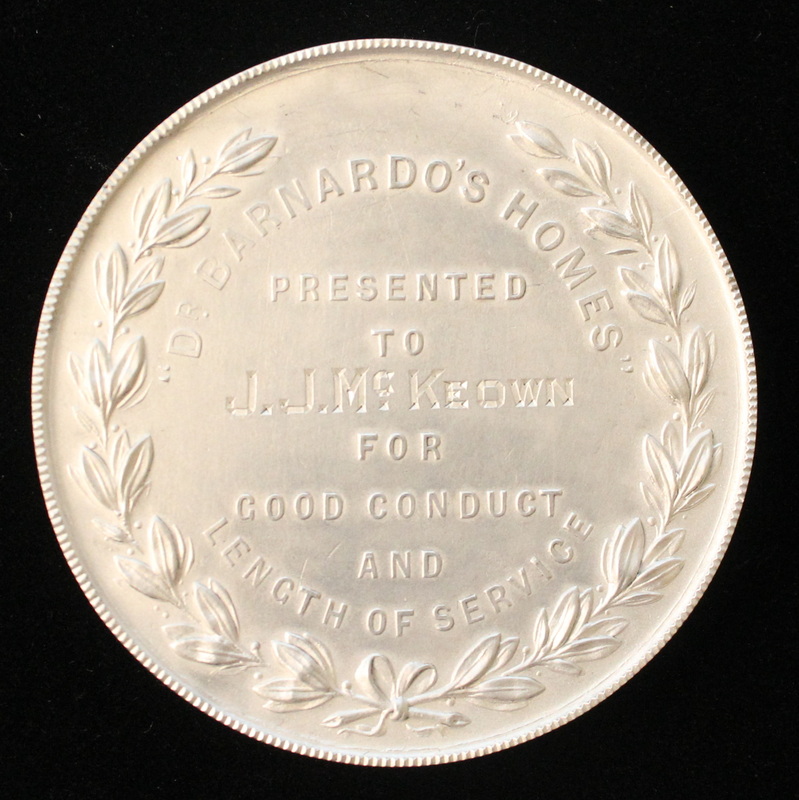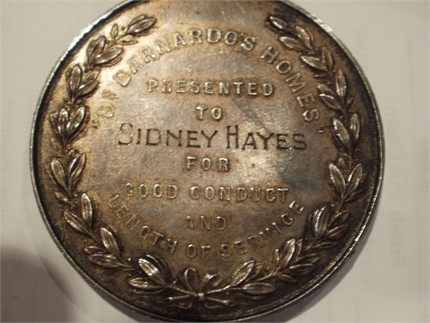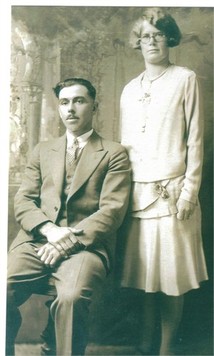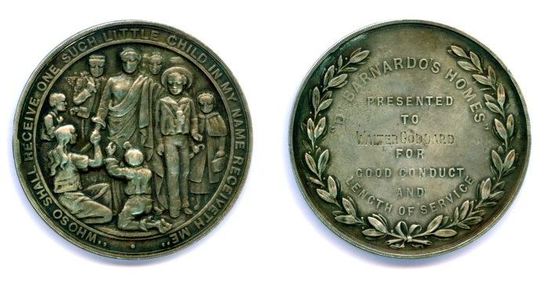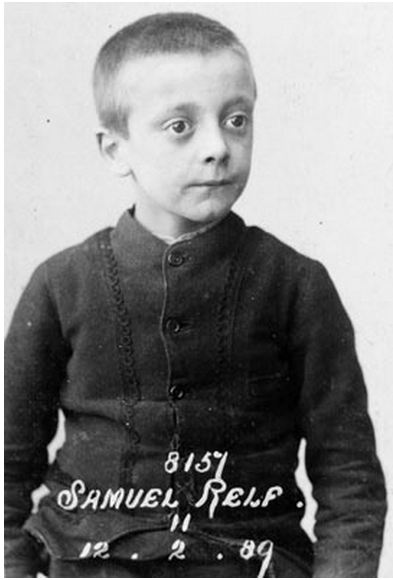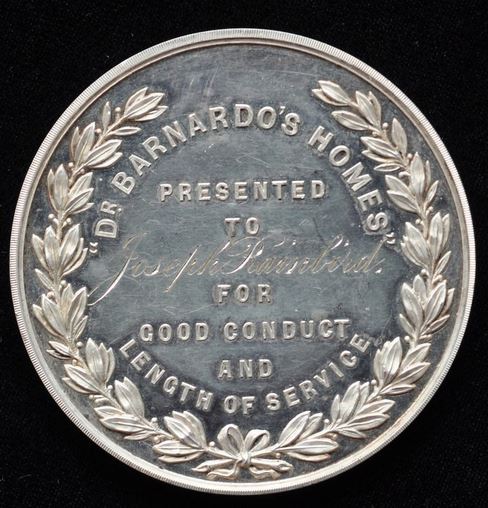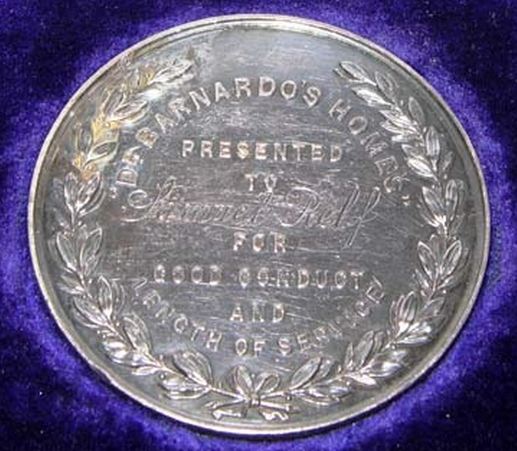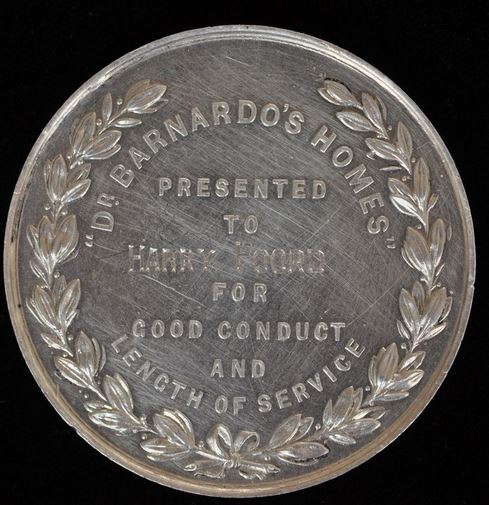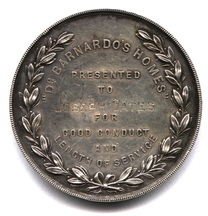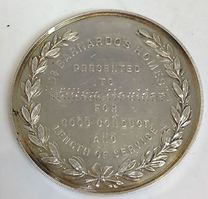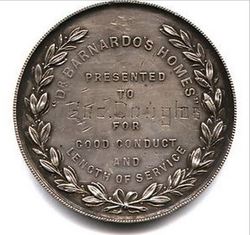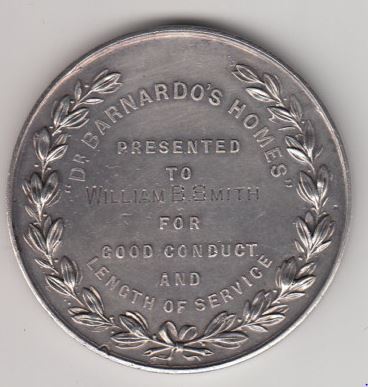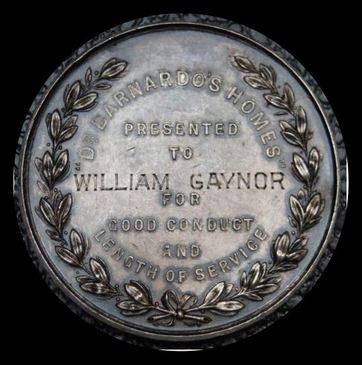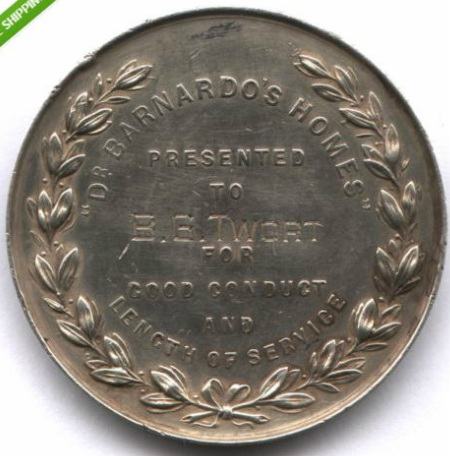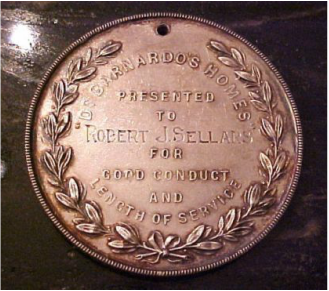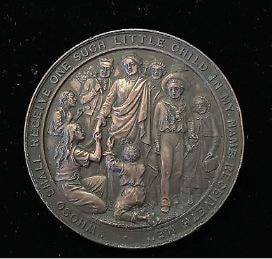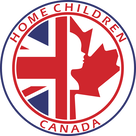Barnardo Home Good Conduct Medals
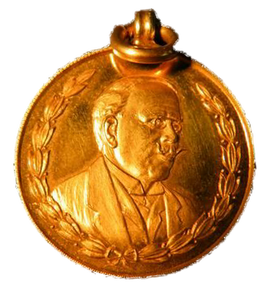 Dr. Barnardo's 5 year gold service medal - we believe given to children in the UK. We have not seen evidence of one awarded in Canada
Dr. Barnardo's 5 year gold service medal - we believe given to children in the UK. We have not seen evidence of one awarded in Canada
Who received the Good Conduct medals and why
From Martine King and Valerie Smith at Barnardo's:
Boys who stayed in their placements one year were awarded a Bronze Good Conduct Medal. Silver medals were awarded after successful completion of two years. Gold medals after five years. [England] This only was in place up to about 1928. However, Canadian notes suggest that on occasion BHCs had to "remind" the Canadian office to send them one and it was not standard practice to give them out on the date they were 'due'. Girls were generally not given one although I have come across girls who did get them; these were often older girls who went as outsiders; someone migrating to Canada who was an adult or young person that hadn’t been in Barnardo’s care but went as part of a Barnardo’s sailing party. There’s normally a note next to their names in the records.
From Martine King and Valerie Smith at Barnardo's:
Boys who stayed in their placements one year were awarded a Bronze Good Conduct Medal. Silver medals were awarded after successful completion of two years. Gold medals after five years. [England] This only was in place up to about 1928. However, Canadian notes suggest that on occasion BHCs had to "remind" the Canadian office to send them one and it was not standard practice to give them out on the date they were 'due'. Girls were generally not given one although I have come across girls who did get them; these were often older girls who went as outsiders; someone migrating to Canada who was an adult or young person that hadn’t been in Barnardo’s care but went as part of a Barnardo’s sailing party. There’s normally a note next to their names in the records.
July 1896
|
A description of the engravings on these medals by Brian Rolfe
From the Roots mailing list
Description of these medals - the engravings:
On the front of each is a quote from the King James Bible, Matthew 18.5, "WHOSO SHALL RECEIVE ONE SUCH LITTLE CHILD IN MY NAME RECEIVETH ME." Inside this ring of words is a picture. Divide the face of the medal into two halves with a diagonal running from the upper left to the lower right. Above this constructed line are 7 standing figures, one of whom is central to the whole design and wears classical garb, a toga-like wrap hanging loosely from one shoulder and flowing down to the ground. The form of a breast evident behind her clothing and possibly her long hair clearly identify her as a female. Those who stand at her sides or behind her are young people neatly and substantially clothed, are usually capped or hatted and with one exception are all facing in precisely the same direction, i.e. towards the viewer. Many show evidence that they have employment: a teenage boy holds a hammer and has a basket over his shoulder that holds some tools or material of his trade; a boy in sailor outfit complete with lanyards; a young girl wearing overcoat with shoulder cape holds a handbag and umbrella; the head of a young woman behind the central Grace-figure has her hair up and contained in the cap of a housemaid or cook.
Beneath the imagined diagonal are 3 more figures, a man and woman and child, all thinly clad, bare-headed and tousle-haired. The woman and child sit or kneel apart on the ground at the feet of the Grace-figure, the woman clasping the Grace's hand; the child, his back to the viewer (of the ten in the picture he alone has no face visible) has arms and hands raised in a "Pick me up. Please." gesture. The man, though standing, is no taller
than a child. Both adults of this trio have faces that are creased with age or care. This alone is enough to distinguish them from the youthful faces of the group of seven. Together these 3 figures below the diagonal, poorly dressed and begging, represent a family. The begging boy and his mother are pleading with the Grace-figure to "Please!" take the boy under her administration, to include him in the ranks of her cohorts, the sturdy, well-dressed, adequately-fed, employed young people at her sides. The father, though one hand is raised is pretty static. By far the most dynamic of the 10 is the boy; second most is the mother, though her posture appears to be something she has grown weary of. The Grace-figure and her cohorts are all posed and still, with emotionless mask-like faces. On the reverse side of both medals is: "For good conduct and length of service."
On the front of each is a quote from the King James Bible, Matthew 18.5, "WHOSO SHALL RECEIVE ONE SUCH LITTLE CHILD IN MY NAME RECEIVETH ME." Inside this ring of words is a picture. Divide the face of the medal into two halves with a diagonal running from the upper left to the lower right. Above this constructed line are 7 standing figures, one of whom is central to the whole design and wears classical garb, a toga-like wrap hanging loosely from one shoulder and flowing down to the ground. The form of a breast evident behind her clothing and possibly her long hair clearly identify her as a female. Those who stand at her sides or behind her are young people neatly and substantially clothed, are usually capped or hatted and with one exception are all facing in precisely the same direction, i.e. towards the viewer. Many show evidence that they have employment: a teenage boy holds a hammer and has a basket over his shoulder that holds some tools or material of his trade; a boy in sailor outfit complete with lanyards; a young girl wearing overcoat with shoulder cape holds a handbag and umbrella; the head of a young woman behind the central Grace-figure has her hair up and contained in the cap of a housemaid or cook.
Beneath the imagined diagonal are 3 more figures, a man and woman and child, all thinly clad, bare-headed and tousle-haired. The woman and child sit or kneel apart on the ground at the feet of the Grace-figure, the woman clasping the Grace's hand; the child, his back to the viewer (of the ten in the picture he alone has no face visible) has arms and hands raised in a "Pick me up. Please." gesture. The man, though standing, is no taller
than a child. Both adults of this trio have faces that are creased with age or care. This alone is enough to distinguish them from the youthful faces of the group of seven. Together these 3 figures below the diagonal, poorly dressed and begging, represent a family. The begging boy and his mother are pleading with the Grace-figure to "Please!" take the boy under her administration, to include him in the ranks of her cohorts, the sturdy, well-dressed, adequately-fed, employed young people at her sides. The father, though one hand is raised is pretty static. By far the most dynamic of the 10 is the boy; second most is the mother, though her posture appears to be something she has grown weary of. The Grace-figure and her cohorts are all posed and still, with emotionless mask-like faces. On the reverse side of both medals is: "For good conduct and length of service."
Sessional Papers, Volume 4; Volume 23, Part 4
By Ontario. Legislative Assembly 1891
Dr. Barnardo explains that the conception of the "Good Conduct Medal" was a method of controlling the children's movements
Good Conduct Medals for Girls in Canada
Good conduct medals were occasionally handed out to girls in Canada. To find these is rare.
Published in 1906 by Dr. Barnardo's wife after her husbands death, she mentions that at this time 5,023 girls had been sent to Canada and 105 have received the service medal. However, to date not many girls medals have been found. .
Published in 1906 by Dr. Barnardo's wife after her husbands death, she mentions that at this time 5,023 girls had been sent to Canada and 105 have received the service medal. However, to date not many girls medals have been found. .
Minnie Charlwood's Good Conduct Medals
Minnie Charlwood arrived in Canada in June of 1885. She was only three years old. Her medals were awarded for her service in Canada. She was awarded a bronze medal and a silver medal.
The Bronze Good Conduct Medal of Louisa Dixon
She arrived August 25 1889
Maude Adams Good Conduct Medals
Maude arrived in Canada September 1901. These were found in the UK on a online auction 2012. Two Dr Barnardo`s service medals, one in bronze and one in silver, both named to Maud Adams, silver example hallmarked from Birmingham 1905, both cased (2) - I suspect this Maude Adams could have been from the UK and not the Maude who came to Canada.
10 Year Service Watch of Maggie Abernethy
Boy's Good Conduct Medals
The Medal of A. Hall
Good Conduct Medal of William T. C. Hawkins
William was killed in the First World War registry number: 7466
William was killed in the First World War registry number: 7466
Good conduct medal of V. Harrison,
likely Victor Harrison, found on e-bay December of 2018
likely Victor Harrison, found on e-bay December of 2018
Presented to J. J. McKeown c 1903
Presented to Walter Goddard
|
Joseph Rainbird - lived in the Dalton area, Ontario arrived pre 1896
|
Presented to Samuel Relf
|
|
William Gaynor
Given Name(s):William Surname:GAYNOR Age:14 Gender:M Ship:DOMINION Port of Departure:Liverpool Date of Departure:1908-05-21 Port of Arrival:Quebec Date of Arrival:1908-05-31 Year of Arrival:1908 Party:Barnardo Homes Destination:Toronto and Peterborough, Ontario Comments:Mr. Lloyd in charge of 109 girls and 219 boys, girls to Peterborough Type of Records:Passenger Lists Microfilm Reel Number:T-493 |
Barnard George TwortGiven Name(s):Barnard George
Surname:TWORT Age:14 Gender:M Ship:SOUTHWARK Port of Departure:Liverpool Date of Departure:1904-03-24 Port of Arrival:Portland Date of Arrival:1904-04-05 Year of Arrival:1904 Party:Barnardo Homes Destination:Toronto, Ontario Comments:Age based on year of birth only. Barnard enlisted and served in the First World War. He died April 27, 1917 in Hamilton of tuberculosis. For his service information please visit our Honour Roll page. |
|
Item: Robert John SELLARS
Given Name(s): Robert John Surname: SELLARS Age: 9 Gender: M Ship: DOMINION Port of Departure: Liverpool Date of Departure: 1908-07-30 Port of Arrival: Quebec Date of Arrival: 1908-08-08 Year of Arrival: 1908 Party: Barnardo Homes Destination: Peterborough and Toronto, Ontario Comments: 118 boys to Toronto and 101 girls to Peterborough Type of Records: Passenger Lists Microfilm Reel Number: T-4759 Children travelling together: Q08BF Source: Library and Archives Canada Reference: RG 76 C1a Item Number: 67825 |
|
Good Conduct medal presented to Charles A. E. HOILE, found on a close online auction site. Find Charles in the BHCARA On-line Registry www.britishhomechildrenregistry.com/Person/bhcInfo/57261 |
The Good Conduct Medal of Alice Pickworth was sold at auction in November of 2019. We do not know it's location
Robert Grey, George Reeves from: Report on Immigration, Part 2 Canada. Dept. of the Interior 1918 - Canada
